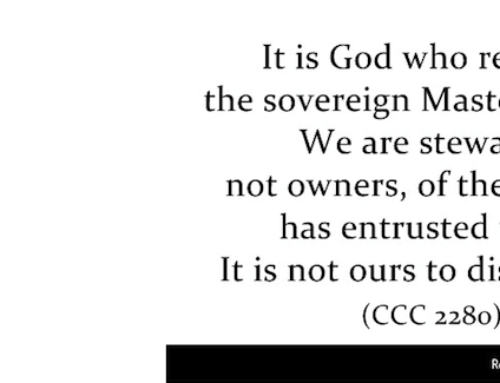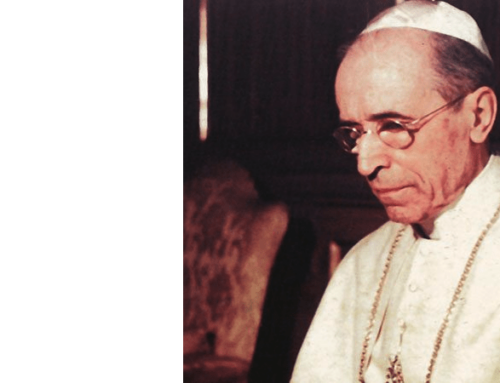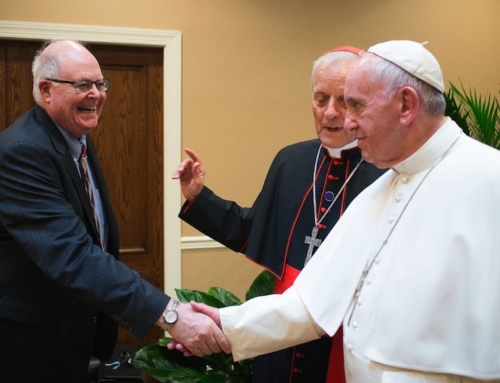(Catalyst, October 2005)
Like most Catholics, I know Mother Angelica through EWTN (Eternal World Television Network). Now, thanks to Ray Arroyo’s inspiring portrait of her, I know her much better. The subtitle of Mother Angelica accurately reads, The Remarkable Story of a Nun, Her Nerve, and a Network of Miracles. Yes, it is all that and more—it is a gripping tale of a woman who suffered greatly yet always managed to beat the odds.
Born Rita Rizzo, and reared in Canton, Ohio, Mother Angelica experienced poverty, a broken home, maltreatment, multiple physical ailments, jealously, back stabbing, betrayal—she was even shot at—but nothing could stop her determination. It does not exaggerate to say that the object of her determination never had anything to do with her—it always had to do with God.
In her lifetime, Mother established the Poor Clare Nuns of Perpetual Adoration and gave birth to the Franciscan Friars of the Eternal Word and the Sisters of the Eternal Word. She built the Shrine of the Most Blessed Sacrament, as well as the largest shortwave network in the world and the world’s first Catholic satellite network. Not bad for a high school graduate who had everything going against her.
Her father was abusive, both physically and verbally, and eventually abandoned her (he tried to reconcile with her later in life). It took such a toll on her that she wondered why God would ever subject a little girl to such a miserable family. It also meant that she missed out on what other kids were used to, so much so that one of her cousins would later say of her, “She was an adult all her life. She never had a childhood.”
The nuns she met in school were anything but kind. Their opposition to divorce unfortunately led them to oppose the children of divorce, and this was something the young Rita couldn’t bear (the priests her mother encountered were just as condemning). Some family members were just as cruel, including an uncle who verbally beat up on her mother so badly that Rita literally threw a knife at him.
Yet there were miracles. There was the time when, at age eleven, she was crossing a street only to see two headlights staring her right in the face. She thought she was dead. Incredibly, she was able to jump high enough that she avoided being hit. The driver called it “a miracle,” while Rita and her mother dubbed it a graceful “lifting.”
Her stomach ailments were so bad that she was forced to wear a corset. The doctors tried to help, but to little avail. Then she met a stigmatic, Rhoda Wise, and that’s when things began to change. One day, when she was 20, a voice told her to get up and walk without the corset, and she did just that. Immediately, her suffering was relieved. Her doctor, of course, insisted it had to with his treatments, but Rita knew better.
Her mother wasn’t too happy when she learned that Rita had decided to enter a Cleveland monastery. After all, she had first been abandoned by her husband, and now her daughter was leaving her as well. But in time she would come to accept it. As for Rita, her failing knees (and the five stories of steps she had to traverse at the monastery), led to her being dispatched back home to Canton.
After nine years in the cloister, Sister Angelica took her solemn vows. Her legs and her back were so twisted she could hardly walk (she wore a body cast), leading her to beg God to allow her to walk again in exchange for a promise: she would build a monastery in the South. What she wanted was a “Negro apostolate,” a cloistered community in service to poor blacks. After undergoing spinal surgery, and after being rebuffed initially by her bishop, she got her way; approval was given to build a monastery in Birmingham. Then came to the hard part—coming up with the bucks to pay for it.
In 1959, the year before she became Mother Angelica, she spotted an ad in a magazine for fishing lure parts. She decided that the nuns would go into the fishing-lure business, thus was St. Peter’s Fishing Lures born. In 1961, Sports Illustrated honored her with a plaque for her “special contribution to a sport.” Remarkably, this half-crippled nun with no business experience was able to garner national attention for her entrepreneurial acumen. It was just the beginning.
Building a monastery in the South in the early 1960s, especially one that would service African Americans, was not exactly a popular enterprise. It didn’t take long before local opposition mounted, even to the point of violence: Mother Angelica was shot at one night by one of the protesters (he barely missed).
Amidst what seemed like eternal struggles to keep the revenue coming, Mother started the Li’l Ole Peanut Company. Score another hit: By the end of 1968, she paid off all the monastery debt. Over the next decade, she would write books and give talks, managing to walk with an artificial hip.
In 1978, her life was forever altered when she was introduced to a TV studio in Chicago. Instantly, she got the bug: she had to have one of her own. Then came the first of many disappointments dealing with the bishops. When she contacted them about a Catholic TV show, none replied. Undeterred, she secured funding from New York philanthropist Peter Grace, and in 1981 got a young lawyer and Catholic deacon, Bill Steltemeier, to craft a civil corporation called the Eternal Word Television Network. Bill would remain a loyal and talented ally throughout the tumultuous times to come.
When word reached Rome that a cloistered abbess was traveling the country in pursuit of her broadcasting dream, she ran into trouble with both American bishops and Vatican officials. But thanks to Cardinal Silvio Oddi, head of the Sacred Congregation for the Clergy, she prevailed.
It was never easy. Every time Mother Angelica thought she was in the clear, another bishop would raise objections to her venture. Indeed, the bishops tried to outdo her by launching their own effort, the Catholic Telecommunications Network of America (CTNA). It was clear from the beginning that Mother Angelica was seen as a threat: EWTN had a traditional orientation and CTNA took a modernist stance. EWTN won. CTNA collapsed.
It was not easy for the bishops to watch their own creation flounder while EWTN won the admiration of Pope John Paul II. Adding to their chagrin was their inability to get Mother Angelica to switch to a new interfaith satellite network. As to her own operations, Mother Angelica did not take kindly to those clerics who questioned her authority to showcase some bishops, but not others. “I happen to own the network,” she instructed. When told that this would not be forever, she let loose: “I’ll blow the damn thing up before you get your hands on it.”
In 1989, a report by the bishops complained that EWTN rejected “one out of every three programs submitted by the bishops conference.” The bishops and Mother Angelica were clearly on a collision course: she had no tolerance for the theological dissidence that was tolerated by many bishops and their staff. The last straw came when the bishops conference sent a show to be aired featuring a cleric promising female ordination under the next pope.
The dissent, whether voiced by the Catholic Theological Society of America, or by feminist nuns who favored gender-neutral language in the Catholic Catechism, distressed Mother badly. She even had to endure being lobbied to push for “inclusive” language in the Catechism by the likes of “conservatives” such as Cardinal Bernard Law of Boston. That he failed should surprise no one.
Mother was more than distressed—she was angered beyond belief—when a woman portrayed Jesus doing the Stations of the Cross at World Youth Day in Denver, 1993. “Try it with Martin Luther King,” she said on the air. “Put a white woman in his place and see what happens.”
She was not prepared for what happened next. The reaction of leading bishops to her outburst was swift and vocal. Archbishop Rembert Weakland, who like Law would later be forced to resign in disgrace, blasted her for what he labeled “one of the most disgraceful, un-Christian, offensive, and divisive diatribes I have ever heard.” He had nothing to say about the incident that provoked her.
The bishops weren’t finished with her. In retaliation, they recalled priests who had been assigned to work at EWTN, and attempts were made to get EWTN thrown off diocesan TV channels around the country.
Just when it seemed things couldn’t get any worse, Mother Angelica and Roger Cardinal Mahony locked horns. In 1997, she accused the Los Angeles archbishop of questioning the Real Presence: “In fact,” she said, “the cardinal of California is teaching that it’s bread and wine before the Eucharist and after the Eucharist.” She added that she would not obey an Ordinary like him if she lived there, and hoped that those who did would no longer provide him with their assent.
That was it. Mahony exploded. But while demanding that Rome punish Mother Angelica—and this went on for years—Mahony’s archdiocese was home to “a cavalcade of dissenters and anti-Vatican agitators.” This is the stuff that drives orthodox Catholics mad.
While she survived in the end, Mother Angelica had to ward off attempts by the bishops to take control of EWTN (one archbishop allegedly told her that certain bishops “want to destroy you”). To make sure this would never happen, Mother Angelica resigned from the network in order to save it: the bishops would have no lien on a purely autonomous, lay-run, civil entity.
Twenty years ago, Ben Armstrong of the National Religious Broadcasters aptly dubbed her, “the Bishop Fulton Sheen of this generation.” Cardinal J. Francis Stafford was also right when he observed that “Mother Angelica represented the plain Catholic, who is 90 percent of the Church.” Let it also be said that she overcame all kinds of adversity, and she did it all—and continues to do it all—for Jesus.






